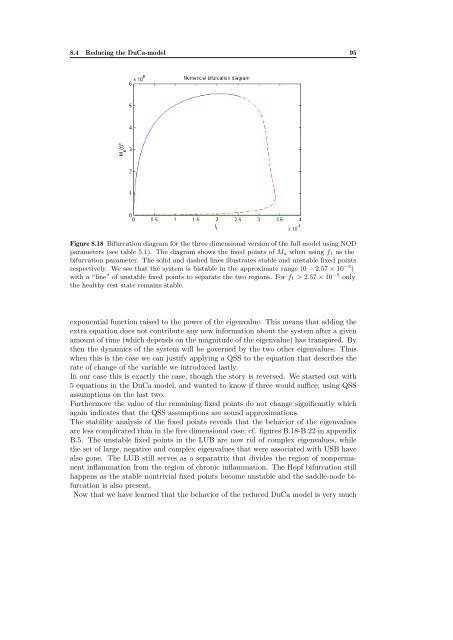nr. 477 - 2011 - Institut for Natur, Systemer og Modeller (NSM)
nr. 477 - 2011 - Institut for Natur, Systemer og Modeller (NSM)
nr. 477 - 2011 - Institut for Natur, Systemer og Modeller (NSM)
Create successful ePaper yourself
Turn your PDF publications into a flip-book with our unique Google optimized e-Paper software.
8.4 Reducing the DuCa-model 95<br />
Figure 8.18 Bifurcation diagram <strong>for</strong> the three dimensional version of the full model using NOD<br />
parameters (see table 5.1). The diagram shows the fixed points of Ma when using f1 as the<br />
bifurcation parameter. The solid and dashed lines illustrates stable and unstable fixed points<br />
respectively. We see that the system is bistable in the approximate range (0 − 2.57 × 10 −5 )<br />
with a “line” of unstable fixed points to separate the two regions. For f1 > 2.57 × 10 −5 only<br />
the healthy rest state remains stable.<br />
exponential function raised to the power of the eigenvalue. This means that adding the<br />
extra equation does not contribute any new in<strong>for</strong>mation about the system after a given<br />
amount of time (which depends on the magnitude of the eigenvalue) has transpired. By<br />
then the dynamics of the system will be governed by the two other eigenvalues. Thus<br />
when this is the case we can justify applying a QSS to the equation that describes the<br />
rate of change of the variable we introduced lastly.<br />
In our case this is exactly the case, though the story is reversed. We started out with<br />
5 equations in the DuCa model, and wanted to know if three would suffice; using QSS<br />
assumptions on the last two.<br />
Furthermore the value of the remaining fixed points do not change significantly which<br />
again indicates that the QSS assumptions are sound approximations.<br />
The stability analysis of the fixed points reveals that the behavior of the eigenvalues<br />
are less complicated than in the five dimensional case; cf. figures B.18-B.22 in appendix<br />
B.5. The unstable fixed points in the LUB are now rid of complex eigenvalues, while<br />
the set of large, negative and complex eigenvalues that were associated with USB have<br />
also gone. The LUB still serves as a separatrix that divides the region of nonpermanent<br />
inflammation from the region of chronic inflammation. The Hopf bifurcation still<br />
happens as the stable nontrivial fixed points become unstable and the saddle-node bifurcation<br />
is also present.<br />
Now that we have learned that the behavior of the reduced DuCa model is very much
















